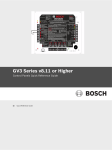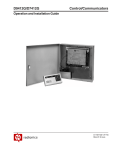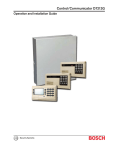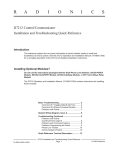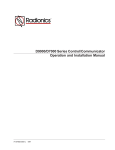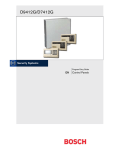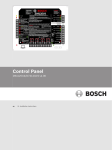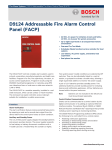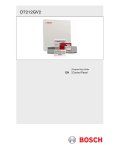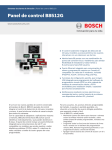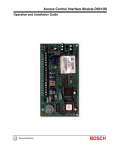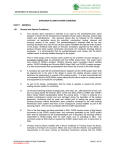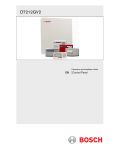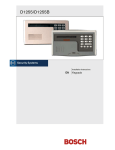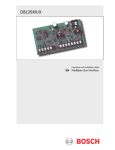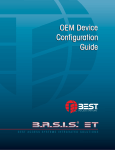Download Bosch D720 Specifications
Transcript
Control Panels D9412G/D7412G/D7212G Installation & Troubleshooting Quick Reference Guide D9412G/D7412G/D7212G Installation & Troubleshooting Quick Reference Guide D9412G/D7412G/D7212G Installation & Troubleshooting Quick Reference Guide 43700F Page 2 © 2004 Bosch Security Systems, Inc. D9412G/D7412G/D7212G Contents Table of Contents 1.0 1.1 1.2 2.0 3.0 3.1 3.2 3.3 3.4 3.5 3.6 3.7 3.7.1 3.8 3.8.1 3.9 3.10 3.11 3.12 3.13 3.14 3.15 3.16 3.16.1 3.17 4.0 4.1 4.2 4.3 4.4 4.5 4.6 4.7 4.8 4.9 Introduction .............................................................................................................................................................................................5 Manual Organization .......................................................................................................................................................................... 5 Other Literature Referenced ............................................................................................................................................. 5 Quick Reference Terminal Description ...................................................................................................................................... 7 Troubleshooting .................................................................................................................................................................................... 9 Introduction ............................................................................................................................................................................. 9 Problems Found During Self Diagnostics ....................................................................................................................... 9 Problems Programming the Panel .................................................................................................................................. 10 Problems With Command Centers ................................................................................................................................ 11 Phone Line Trouble ............................................................................................................................................................. 11 Communication Failure ..................................................................................................................................................... 12 Problems with Points .......................................................................................................................................................... 13 Extra Points ........................................................................................................................................................................... 14 Problems with the D8125 POPEX Data Expansion Loops ...................................................................................... 15 Metering the Loops ............................................................................................................................................................ 15 EMI on Long Wire Runs ................................................................................................................................................... 16 Checking Shielded Cable ................................................................................................................................................ 16 Battery and Power Reports .............................................................................................................................................. 16 Watchdog Reset Reports ................................................................................................................................................. 17 Runaway Reports to the Receiver ................................................................................................................................. 17 Overloaded Power Supply ................................................................................................................................................ 17 Service Walk Test ............................................................................................................................................................... 18 Ground Fault ....................................................................................................................................................................... 2 0 Procedure for Isolating Earth Ground Faults ............................................................................................................... 20 Panel Buzzer ......................................................................................................................................................................... 21 System Wiring Diagrams, Issue A ............................................................................................................................................ 23 D9412G Control Panel, 1 of 3 ...................................................................................................................................... 2 3 D9412G Control Panel, 2 of 3 ...................................................................................................................................... 2 4 D9412G Control Panel, 3 of 3 ...................................................................................................................................... 2 5 D7412G Control Panel, 1 of 3 ...................................................................................................................................... 2 6 D7412G Control Panel, 2 of 3 ...................................................................................................................................... 2 7 D7412G Control Panel, 3 of 3 ...................................................................................................................................... 2 8 D7212G Control Panel, 1 of 3 ...................................................................................................................................... 2 9 D7212G Control Panel, 2 of 3 ...................................................................................................................................... 3 0 D7212G Control Panel, 3 of 3 ....................................................................................................................................... 31 D9412G/D7412G/D7212G Installation & Troubleshooting Quick Reference Guide © 2004 Bosch Security Systems, Inc. Page 3 43700F D9412G/D7412G/D7212G Contents Figures Figure 1: Service Walk Test Flow Chart ....................................................................................................................................... 19 Figure 2: D9412G System Wiring Diagram ................................................................................................................................ 23 Figure 3: D9412G System Wiring Diagram ................................................................................................................................ 24 Figure 4: D9412G System Wiring Diagram ................................................................................................................................ 25 Figure 5: D7412G System Wiring Diagram ................................................................................................................................ 26 Figure 6: D7412G System Wiring Diagram ................................................................................................................................ 27 Figure 7: D7412G System Wiring Diagram ................................................................................................................................ 28 Figure 8: D7212G System Wiring Diagram ................................................................................................................................ 29 Figure 9: D7212G System Wiring Diagram ................................................................................................................................ 30 Figure 10: D7212G System Wiring Diagram .............................................................................................................................. 31 Tables Table 1: Chapter Summary ................................................................................................................................................................ 5 Table 2: Referenced Literature ......................................................................................................................................................... 5 Table 3: Quick Reference Terminal Description ........................................................................................................................... 7 Table 4: Troubleshooting Problems Found During Self Diagnostics ....................................................................................... 9 Table 5: Troubleshooting Problems Programming the Panel ................................................................................................... 10 Table 6: Troubleshooting Command Center Problems ............................................................................................................. 11 Table 7: Troubleshooting Phone Line Problems ......................................................................................................................... 11 Table 8: Troubleshooting Communication Failures .................................................................................................................... 12 Table 9: Troubleshooting Problems with Points .......................................................................................................................... 13 Table 10: Data Expansion Loop Wire Specifications ............................................................................................................... 15 Table 11: Terminal Grouping Ground Fault ................................................................................................................................. 20 D9412G/D7412G/D7212G Installation & Troubleshooting Quick Reference Guide 43700F Page 4 © 2004 Bosch Security Systems, Inc. D9412G/D7412G/D7212G Introduction 1.0 Introduction This reference contains the very basic information a trained installer needs to install and troubleshoot a D9412G, D7412G, or D7212G Control Panel system. 1.1 Manual Organization This manual is divided into four sections, which are summarized in Table 1. Section No. 1 2 2 4 Description Introduction – information about organization of the manual and additional literature that may be ordered. Quick Reference Terminal Description – description of panel terminals presented in a quick reference table. Basic Troubleshooting – basic troubleshooting solutions and procedures to resolve common problems during programming and installation of the D9412G, D7412G, and D7212G Control Panels. System Wiring Diagrams, Issue A – reference drawings showing the wiring diagrams for the D9412G, D7412G, and D7212G Control Panels. Table 1: Chapter Summary D9412G/D7412G/D7212G Installation & Troubleshooting Quick Reference Guide © 2004 Bosch Security Systems, Inc. Page 5 43700F D9412G/D7412G/D7212G Introduction 1.2 Other Literature Referenced For a more complete and detailed description of the D9412G/D7412G/D7212G Control Panels, see the additional literature referenced by part number for easy ordering in Table 2. Document Name D1255 Installation Instructions D1256/D1257 Installation Instructions D1260 Installation Guide D1260 Owner’s Manual D5200 Operation Manual D720 Installation Instructions D7212G Approved Applications Compliance Guide D7212G Operation and Installation Guide D7212G Program Entry Guide D7212G Program Record Sheet D7212G Release Notes D7412G Release Notes D8125MUX Operation and Installation Guide D9210B Operation and Installation Guide D9412G Release Notes D9412G/D7412G Approved Applications Compliance Guide D9412G/D7412G/D7212G Installation and Troubleshooting Quick Reference Guide D9412G/D7412G New Features D9412G/D7412G Operation and Installation Guide (this manual) D9412G/D7412G/D7212G Point Chart Label D9412G/D7412G Program Entry Guide D9412G/D7412G Program Record Sheet RAM IV Operations Manual Security System Owner's Manual Security System Owner's Manual Supplement UL Certificated Bank Safe and Vault Applications Technogram 9000/9000G Series Smoke Detector Compatibility List Part Number 74-06819-000 74-06925-000 48101 50410 74-06176-000 74-06918-000 4998138560 4998138544 4998138538 4998138542 4998138543 43856 36796 32206 43821 43494 43700 43746 43488 79-06660-000 47775 47488 38849 71-06633-000 33267 73-07302-000 33284 Table 2: Referenced Literature D9412G/D7412G/D7212G Installation & Troubleshooting Quick Reference Guide 43700F Page 6 © 2004 Bosch Security Systems, Inc. D9412G/D7412G/D7212G Quick Reference Terminal Description 2.0 Quick Reference Terminal Description Terminal 1, 2 3 Name CLASS 2 TRANSFORMER + AUX POWER 4 BATTERY NEGATIVE ONLY 5 (+) BATTERY POSITIVE ONLY 6 (+) + STEADY OR PULSED ALARM POWER + ALTERNATE ALARM POWER 7 (+) 8 (+) + SWITCHED AUX POWER 9 COMMON 10 EARTH GROUND 11, 13, 14, 16, 17, 19, 20, 22 12, 15, 18, 21 24 (+) ON-BOARD POINTS (Inputs) ON-BOARD POINTS (Common) ZONEX COMMON ZONEX POWER + 25 26 27 28 29 (-) 30 31 ZONEX IN 2 ZONEX OUT 2 ZONEX IN 1 ZONEX OUT 1 COMMON DATA BUS B DATA BUS A 32 (+) POWER + 23 (-) Description Connect 16.5 VAC, 40 VA transformer for primary power supply. Supplies up to 1.4 A at 10.2 VDC to 13.9 VDC to powered devices. Use Terminal 9 for common. Shares PTC with Terminal 24. Connect rechargeable lead acid type battery’s negative terminal (-) to Terminal 4. (See the Current Rating Charts section in the panel’s Approved Applications Compliance Guide to determine battery size requirements.) Connect rechargeable lead acid type battery’s positive terminal (+). (See the Current Rating Charts section in the panel’s Approved Applications Compliance Guide to determine battery size requirements.) Supplies up to 2 A at 10.2 VDC to 13.9 VDC for steady or pulsed alarm output. Use Terminal 9 for common. Programmed as Relay A. Shares PTC with Terminals 7 and 8. Supplies up to 2 A at 10.2 VDC to 13.9 VDC for steady or pulsed alarm output. Use Terminal 9 for common. Programmed as Relay B. Shares PTC with Terminals 6 and 8. D136 Plug-in Relay required: Install a D136 in the ALT ALARM socket for output at Terminal 7. Supplies up to 1.4 A at 10.2 VDC to 13.9 VDC. Use Terminal 9 for common. Programmed as Relay C. Continuous output interrupted by RESET SENSORS or alarm verification. Shares PTC with Terminals 6 and 7. D136 Plug-in Relay required: Install a D136 in the SW AUX socket for output at Terminal 8. Terminal 9 is common for Auxiliary Power, Steady or Pulsed Alarm Power, Alternate Alarm Power, and Switched Aux Power (Terminals 3, 6, 7, and 8). Connect to earth ground. A cold water pipe or grounding rod is preferred. Do not connect to telephone or electrical ground. Connect normally open and/or normally closed detection devices to loop wiring. 1 kΩ resistor required at end of loop. Loop returns for on-board points. [D9412G only] Use Terminals 23 and 24 to power ZONEX modules such as the D8125 POPEX module, the D8128D OctoPOPIT, and the D8129 OctoRelay. Shares PTC with Terminal 3. [D9412G only] Connect ZONEX modules for Points 129 to 247 and Relays 65 to 128 to these terminals. Connect ZONEX modules for Points 9 to 127 and Relays 1 to 64 to these terminals. (The D7412G uses Points 9 to 75, the D7212G uses Points 9 to 40.) Common terminal for SDI devices. Terminals 30 and 31 are a two-wire bus that drives the command centers, printer interface, and access control modules including the D9133TTL-E Ethernet Interface Module, D9133DC Direct Connect Module, D9133 Serial Interface Module, and the PC9133TTL-E Ethernet Interface Module. Power for SDI devices. Shorts on any other terminal do not affect this separate, protected power output for SDI devices. Table 3: Quick Reference Terminal Description D9412G/D7412G/D7212G Installation & Troubleshooting Quick Reference Guide © 2004 Bosch Security Systems, Inc. Page 7 43700F D9412G/D7412G/D7212G Quick Reference Terminal Description Notes: D9412G/D7412G/D7212G Installation & Troubleshooting Quick Reference Guide 43700F Page 8 © 2004 Bosch Security Systems, Inc. D9412G/D7412G/D7212G Troubleshooting 3.0 Troubleshooting 3.1 Introduction Bosch Security Systems provides this guide to help troubleshoot problems with the D9412G/D7412G/D7212G. To prevent problems from occurring, read the preceding sections of this guide and the panel’s Program Entry Guide to verify that the panel is correctly installed and programmed. 3.2 Problems Found During Self Diagnostics The D9412G/D7412G/D7212G Control Panels perform a series of self-diagnostic tests of hardware, software, and program at start up and reset. Buzzer sounding is normal at start-up: The on-board buzzer located on the lower right corner of the panel sounds as the control/ommunicator performs its self diagnostic tests at start up and reset. The tests take less than two seconds. If all tests are completed successfully, the buzzer turns off. The panel continues periodic internal testing during normal operation. If a fault is detected during this testing, the buzzer begins sounding. One of the system messages listed below displays at the command centers. Symptom CALL FOR SERVICE appears in the command center's display. No buzzer sounds at the Command Center. COMM FAIL ROUTE # appears in command center displays. Diagnosis A command center has stopped receiving data from the panel. Remedy Check the wiring for opens, grounds, or shorts. The panel has made ten unsuccessful attempts to report to the receiver. PANEL BROKEN appears in the displays of all command centers, the command center buzzer sounds, and the green operation monitor LED stops flickering or is off. PARAM FAIL alternates with the idle text at the command centers, the command center buzzer sounds, the green operation monitor LED continues to flicker, and the panel sends a BAD PARAM CKSUM report to the receiver. SERVC AC FAIL appears in command center displays. A hardware or software problem has occurred. See Section 3.6 Communication Failure on page 12. Pressing [ESC] silences the buzzer. The display clears when communication restores (i.e., the receiver acknowledges a report). Pressing [ESC] does not silence the buzzer. The panel must be returned to Bosch Security Systems for repair. The program is corrupted. Pressing [ESC] may silence the buzzer. Silencing the buzzer does not correct the problem: The corrupted copy of the program in the panel must be replaced. Load a new copy of the complete program. The displays clear when the panel is reset after loading a new program. AC power has been interrupted at Terminals 1 and 2. Pressing [ESC] silences the buzzer. Restoring power clears the display. NOTE: You can program the panel to send an AC FAIL report to the receiver. See Section 3.11 Battery and Power Reports on page 16 for probable causes and remedies. Pressing [ESC] silences the buzzer. The display clears when battery voltage reaches 13.7 VDC. Pressing [ESC] silences the buzzer. Restoring the battery clears the display. NOTE: The panel can be programmed to send a BATTERY MISSING report to the receiver. SERVC BATT LOW appears in command center displays. Battery voltage at Terminals 4 and 5 has fallen below 12.1 VDC. SERVC BATT MSING appears in command center displays. The panel cannot detect a battery at Terminals 4 and 5. Table 4: Troubleshooting Problems Found During Self Diagnostics D9412G/D7412G/D7212G Installation & Troubleshooting Quick Reference Guide © 2004 Bosch Security Systems, Inc. Page 9 43700F D9412G/D7412G/D7212G Troubleshooting Symptom SERVC GND FAULT appears in command center displays. Diagnosis The panel has detected an earth ground fault. SERVC KEY PAD appears at other command centers connected to the panel.and the panel transmits an SDI FAILURE report to the receiver. SERVC 9210 #n appears at the other command centers connected to the panel and the panel transmits an SDI FAILURE ## report to the receiver. SERVC PH LINE #1 (or SERVC PH LINE #2 if two lines are used) appears in command center displays. SERVC PRINTER appears in command center displays. The panel has lost contact with a supervised command center. Remedy Follow the steps in Section 3.16.1 Procedure for Isolating Earth Ground Faults on page 20. See Section 3.5 Connecting Earth Ground in the D9412G/D7412G Operation and Installation Guide (P/N: 43488). Pressing [ESC] silences the buzzer. The displays clear when contact with the missing Command Center restores. The panel has lost contact with a D9210B Access Interface Module. Check the wiring for opens, grounds, or shorts. The panel has detected a phone line as faulted. See Section 3.5 Phone Line Trouble on page 11. See Section 6.8 Phone Line Monitor in the D9412G/D7412G Operation and Installation Guide (P/N: 43488) for a complete description. Pressing [ESC] silences the buzzer. The displays clear when contact with the missing printer restores. The panel has lost contact with a supervised printer. Table 4 (cont’d): Troubleshooting Problems Found During Self Diagnostics 3.3 Problems Programming the Panel Before attempting to program the panel, become familiar with the basic operation of the D5200 programmer. See the D5200 Operation Manual (P/N: 74-06176-000). If problems are still experienced, check for the symptoms below: Symptom The programmer displays PLUG IN PANEL when you press [SEND] or [RECEIVE]. After plugging in the programmer, the panel transmits SDI TROUBLE reports for supervised SDI devices (command centers, Printer Interface Modules, etc.). All SDI devices stop operating. Diagnosis The programmer is not correctly connected to the panel. AC induction through the on-board point sensor loops, the DATA bus, or the ZONEX bus. You must lock the rest pin when programming the panel with a D5200. Remedy Verify that the data/power cord is plugged into the COMMUNICATOR port on the D5200. Verify that the data/power cord is plugged securely into the panel’s Programmer Connector. Check each conductor in the data/power cord for continuity. Verify a proper earth ground at Terminal 10. Disconnect on-board point sensor loops, the DATA bus (Terminals 30 & 31), and the ZONEX bus (Terminals 25 – 28). Lock the reset pin. Table 5: Troubleshooting Problems Programming the Panel D9412G/D7412G/D7212G Installation & Troubleshooting Quick Reference Guide 43700F Page 10 © 2004 Bosch Security Systems, Inc. D9412G/D7412G/D7212G Troubleshooting 3.4 Problems With Command Centers Symptom Command centers show erratic behavior. For example, the pip that confirms you pressed a key echoes. NO AUTHORITY displays at the command center when you enter your passcode to perform a function. Diagnosis Remedy More than one Use a supervised address in one command center only command center has or use a different supervised address for each the same supervised command center. address. Check that yellow and green data wires are correctly Data connections connected on all command centers. (yellow and green wires) on one or more command centers are reversed, or only one wire is connected. Check the User Interface section of the program to be sure the function is enabled for the authority level assigned to the passcode in the Passcode Worksheet section of the program. Check the Passcode Worksheet section of the program to be certain the passcode is assigned to the area where you are attempting to perform the function. Check the Passcode Worksheet section of the program to see if the passcode is restricted by a user window. Check the Area Parameters section of the program to be certain the area in which you are attempting to perform the function is turned on. Table 6: Troubleshooting Command Center Problems 3.5 Phone Line Trouble Phone line problems that are not corrected can result in the panel going into Communications Failure. The D9412G/D7412G can be programmed to monitor one or two phone lines. See the D9412G/D7412G Program Entry Guide (P/N: 47775) for programming instructions. If the phone line monitor is enabled, SERVC PHONE LINE #1 (or SERVC PHONE LINE #2 if two lines are used) appears in the command center’s display when the panel detects a problem on the phone line. System SERVC PH LINE #1 (or SERVC PH LINE #2 if two lines are used) appears in the command center display. Diagnosis The panel’s phone line monitor detects a phone line as faulted. Remedy Verify that the telephone cord is correctly connected to the phone jack and the panel. Verify the Ground Start Jumper is in the correct position. If using a ground start phone line, verify a D136 relay is correctly installed in the Ground Start Relay socket. Verify that the phone jack (RJ31X or RJ38X) is wired correctly. The incoming phone line must be wired to Terminals 4 and 5. The in-house phone system must be wired to Terminals 1 and 8. Verify that all telephones are on-hook. Leaving a telephone on hold after the other party hangs up creates an off-hook condition. Verify that no phones are on-hold. If completing the steps above does not restore the phone line, meter the line. You should meter at least 3.0 VDC. If your readings are below the minimum values, contact your telephone company repair service. Table 7: Troubleshooting Phone Line Problems D9412G/D7412G/D7212G Installation & Troubleshooting Quick Reference Guide © 2004 Bosch Security Systems, Inc. Page 11 43700F D9412G/D7412G/D7212G Troubleshooting 3.6 Communication Failure The panel goes into Communication Failure after ten unsuccessful attempts to reach the receiver. Follow the procedure in Section 3.5 Phone Line Trouble on page 11 to verify that there is no problem with the phone lines at the installation. If the phone lines are good, monitor the lines (preferably at the receiver) for the symptoms listed below. Symptom Diagnosis Remedy Line is not ringing at Verify that the lines are correctly connected to the The line rings but the D6500 the receiver. receiver. receiver does not pick up. The Verify that correct prefixes and phone numbers for the Ring indicator LED on line card receiver have been programmed into the panel. does not light. You cannot hear If completing the steps above does not correct the ring with headset at receiver problem, contact your telephone company repair location. service. The panel is unable to call out The total current Put command centers on a separate power supply to when all 246 points are faulted. draw is too much for get maximum current draw from points in alarm. the panel. The line rings but the receiver Line card in receiver Review receiver manuals for troubleshooting does not pick up. The Ring may be faulty. procedures. Indicator LED on line card lights. You can hear ring with test set at receiver location. The panel reaches a busy signal for Calls are not reaching Verify that correct prefixes and phone numbers for the all ten attempts to reach the the receiver. receiver have been programmed into the panel. receiver. Verify that the phone lines are not shorted between the phone company's equipment and the receiver by placing a call to the number for the receiver. If you hear the line ring, but the ring detector doesn't light, or if you hear a busy signal and the green on line (OL) indicator is not lit, call the phone company for service. The receiver's call Additional line cards and phone lines may be needed load is too great. for the receiver The receiver answers the call and The receiver is not Verify that the receiver is producing a 1400 Hz, 2300 provides an acknowledgment producing the correct Hz, or Modem IIIa2 acknowledgment tone. tone, but the communicator does acknowledgment not transmit reports. tone. Panel does not connect to central The D136 relay used Insert the D136 relay in the GND STARTsocket station. for ground start correctly. Also check that phone line is connected and phone systems is that phone jack is wired properly. See the Ground Start inserted incorrectly. section in the panel’s Operation and Installation Guide for instructions. Verify that the receiver is compatible with the format The receiver answers the call and The receiver is not the panel is using (either BFSK or Modem IIIa2 provides an initial “handshake” compatible with the acknowledgment, but does not panel’s transmission Communications Format). See the Telephone acknowledge the panel’s report format. Connections section in the panel’s Program Entry transmission with a “kiss-off” Guide. acknowledgment. The panel requires D6500 MPU and Line Card EPROM revision 8.00 or higher. Noisy phone lines are Try making a voice call to the receiver on the line to verify the noisy condition. It may be necessary to have interfering with the phone company check the lines. report transmission. Table 8: Troubleshooting Communication Failures D9412G/D7412G/D7212G Installation & Troubleshooting Quick Reference Guide 43700F Page 12 © 2004 Bosch Security Systems, Inc. D9412G/D7412G/D7212G Troubleshooting 3.7 Problems with Points If the switches on a POPIT are set incorrectly, it may create both a missing and extra point. When a missing point is found, perform a Service Walk Test to search for extra points. See the Owner’s Manual for test instructions. Symptom Point appears as missing at command centers and in reports to the receiver. Diagnosis POPIT is not connected or incorrectly connected to the data expansion loop. D8128C OctoPOPIT is installed at the last address on the ZONEX bus. Sensor loop switch (1 to 8) is turned off on D8128D OctoPOPIT. POPIT is not programmed correctly. Points intermittently appear as missing. Points are erratic. One or more points remain in trouble or alarm with all devices connected to the sensor loops normal. Faulted points do not generate alarms or troubles as programmed. Problem with data expansion loop. Debounce Count parameter set at 1. If an off-board point is in transition between normal and faulted conditions as the panel scans it, it appears as missing. The sensor loop is open, shorted, or grounded. Opens, shorts, or grounds cause troubles or alarms depending on point programming. Sensor Reset pressed at the time the alarm or trouble was generated. Two points are programmed with the same address. Remedy Verify that a POPIT module programmed for the missing point number is connected to the data expansion loop of the correct ZONEX module. Points 9 to 127 connect to ZONEX module 1. Points 129 to 247 connect to ZONEX module 2. Meter each POPIT to verify the polarity of the data expansion loop. Voltage should be 9 to 13 VDC at each POPIT. Install a D8125 POPEX and D9127 POPITs for points 121-127 on ZONEX 1 and for points 241-247 on ZONEX 2 when using D8128C OctoPOPITs. If the sensor loop switch on D8128D OctoPOPIT is turned off for a programmed point, the point reports as missing. Verify that the switches on the POPIT are set for the missing POPIT number. Switches set incorrectly can cause both missing and extra POPITs. Performing a Service Walk Test to search for extra points may help diagnose the problem. See Section 3.8 Problems with the D8125 POPEX Data Expansion Loops on page 15. It is recommended that the Debounce Count be left at the default of 2. Decreasing the Debounce Count to 1 may cause points to appear as missing. Increasing the Debounce may cause missed alarms. Remove the sensor loop from the panel or POPIT and meter it for continuity. There should be no more than 100 Ω resistance, plus the value of the end of line resistor on the wires. If you meter less resistance than the value of the end of line resistor, check the wiring for shorts. With the wires for the loop removed, meter them for continuity to ground. See Section 3.16 Ground Fault on page 20 for additional information. The panel ignores input from all points in the same area programmed for sensor reset during sensor reset. Points programmed with the same address do not function correctly. Check to be certain that you have not duplicated point addresses. Table 9: Troubleshooting Problems with Points D9412G/D7412G/D7212G Installation & Troubleshooting Quick Reference Guide © 2004 Bosch Security Systems, Inc. Page 13 43700F D9412G/D7412G/D7212G Troubleshooting System Panel transmits PT BUS TROUBLE reports. Erroneous alarm and/or trouble reports may follow PT BUS TROUBLE report. Erroneous alarm and/or trouble events for off-board points appear at command centers. All off-board points are MISSING. Keyswitch points (P## Type is programmed as 4, 5, 6, 7, or 9) report as missing. If area is armed, the point reports a MISSING ALARM. If the area is disarmed, the point reports a MISSING TROUBLE. Connected points show as extra points when the point bus is shorted beyond the programmed debounce time. Diagnosis Short on D8125 POPEX module’s Data Expansion Loop or short on panel’s ZONEX data terminals (25 & 26, or 27 & 28). The POPIT address switches are set incorrectly (for points 128 or 248) or the OctoPOPIT address switches are set incorrectly. Short on Aux Power, terminal 3 or ZONEX power, terminal 24. If only one POPEX module is connected to the panel, POPEX module may be incorrectly connected to the panel or Data Expansion Loop may be disconnected from POPEX module. Point is disconnected from the Popit data bus. The POPIT cover may have been removed and not replaced or the cover is not seated properly. The points have no point index programmed. Remedy A short on either the Data Expansion Loop or the ZONEX data terminals generates a PT BUS TROUBLE report. While the short remains, the panel responds as though the sensor loop for each point connected to the POPEX module was shorted. Check wiring for shorts. Check to be certain all POPIT and OctoPOPIT address switches are set correctly. POPITs cannot be used for points 128 or 248 (these are reserved for panel functions). D8128C OctoPOPITs cannot be used for Points 121-128 or 241-248. D8128D OctoPOPITs cannot use Points 128 or 248. Terminals 3 and 24 share a common circuit breaker. Check wiring and devices connected to these terminals for shorts or grounds. Check POPEX module for correct connections to the panel and the Data Expansion Loop. If you find missing points, the service walk test may help you diagnose the problem (see Section 3.7.1 Extra Points). The point will restore when the Popit bus is reconnected or when the POPIT cover is seated firmly on the POPIT. This will be corrected when the short is returned to normal. Table 9 (cont’d): Troubleshooting Problems with Points 3.7.1 Extra Points If the panel is not in the service walk test mode when an extra point trips, the panel responds to it as a local TROUBLE event at the command center or central station (see Routing in the panel’s Program Entry Guide). It displays the custom text for the point number set in the point’s dipswitch or on-board point location. When an extra point is tripped during the service walk test, it reports as an EXTRA point in the panel’s event log and at the local printer (if installed). Once an extra point is identified, check the programming to see if it has a Point Index programmed and if so, if the point index is appropriate for the application and has the correct area assignment. D9412G/D7412G/D7212G Installation & Troubleshooting Quick Reference Guide 43700F Page 14 © 2004 Bosch Security Systems, Inc. D9412G/D7412G/D7212G Troubleshooting 3.8 Problems with the D8125 POPEX Data Expansion Loops EMI (Electro-magnetic Interference), excessive resistance, or intermittent grounds, shorts, or opens on the data expansion loop can cause erratic or intermittent functioning of points. If EMI may be a problem, see Section 3.9 EMI on Long Wire Runs on page 16. AC induction on the data expansion loops must be less than 1.0 VAC. If EMI is not suspected as the cause of the problem, follow the procedures below to find the source of problems on the data expansion loop or use the Zonex Point Identification Validation Process (P/N: 43049) for a detailed procedure and worksheets to identify and validate all points. 3.8.1 Metering the Loops Before following the procedures below to meter the data expansion loops, check Table 10 to verify the correct gauge wire for the length of the data expansion loops was used. Maximum Length of all Data Expansion Loops Combined AWG Length in ft. (m) 22 1800 (548) 20 2890 (881) 18 4600 (1402) 16 7320 (2231) 14 11650 (3551) Table 10: Data Expansion Loop Wire Specifications When metering the loop, monitor it long enough to observe an intermittent problem. To meter the data expansion loop without POPITs connected to it: 1. Disconnect the loop from the POPEX Module. 2. Twist the positive and then the negative wires together at each POPIT location so that the positive and negative wires are continuous to the last POPIT location. 3. At the last POPIT location twist the end of the positive wire to the negative wire to form one continuous loop. 4. Meter the loop for continuity from the point where it connected to the POPEX Module. Resistance for the entire loop must be less than 60 Ω. If there is no continuity, find and repair the open on the loop. 5. Still metering for continuity, untwist the negative and positive wires at the last POPIT location. If the meter does not show an open condition, find and repair the short on the loop. 6. Twist the positive and negative wires at the last POPIT location back together. 7. Meter the loop for continuity to Terminal 10 (earth ground). If there is continuity, find and remove the foreign ground on the loop. 8. Meter the loop to Terminal 10 for AC voltage. AC induction on data expansion loops must be less than 1 VAC. Try using shielded cable to reduce AC induction if the AC voltage exceeds 1 VAC. D9412G/D7412G/D7212G Installation & Troubleshooting Quick Reference Guide © 2004 Bosch Security Systems, Inc. Page 15 43700F D9412G/D7412G/D7212G Troubleshooting 3.9 EMI on Long Wire Runs EMI (ElectroMagnetic Interference) can cause problems on long wire runs for serial devices (command centers, POPITs, etc.). The use of shielded cable reduces the effect of this interference. Some potential sources of noise on a long wire run include: • Radio or television transmitter site. • Ham radio operator’s transmitter site. • Computer network system. • Heavy machinery (large electrical motors). • PBX telephone system. • High voltage electrical equipment or transformers (arc welders, certain medical and dental equipment, etc.). • Public service office using radio communications (fire department, police department, etc.). • Close proximity to electrical lines, telephone cabling, or fluorescent lighting fixtures. There are many other possible sources of noise. If noise may be a problem, the use of shielded wire is strongly recommended. Connect the drain wire from the shielded cable to Terminal 10 on the panel. The drain wire must have continuity from the panel to the last device on the wire run. If the cable is cut to install devices between the last device and the panel, be certain to reconnect the drain wire to insure continuity to the last device. If continuity is not maintained between the panel and the last device, the shielded cable may aggravate potential noise problems rather than eliminate them. Connecting the drain wire to ground at other than Terminal 10 on the panel may also produce problems. Do not connect the drain wire to any other ground source. 3.10 Checking Shielded Cable If improperly installed, shielded cable can create problems rather than solve them. Follow the procedure below to check shielded cable for proper installation: 3.11 1. Remove the drain wire for the shield from Terminal 10. 2. Meter the drain wire for continuity to Terminal 10 (earth ground). If there is continuity, find and remove the foreign ground on the drain wire. 3. Reconnect the drain wire to Terminal 10. 4. Meter the shield at the far end of the cable (last POPIT location on data expansion loops) for continuity to a ground reference. If there is no continuity, find and repair the open in the shield. Solder and tape all connections. Battery and Power Reports The panel can be programmed to transmit both battery and AC power status reports. Refer to the panel’s Program Entry Guide. If battery or AC power reports are a problem check the following: 1. Check to be sure the panel's power supply is not overloaded. Review Section 2.0 Quick Reference Terminal Description on page 7 and Section 3.14 Overloaded Power Supply on page 17. 2. Verify that there is at least 16.5 VAC on Terminals 1 and 2. 3. The outlet the transformer is plugged into should meter between 110 VAC and 120 VAC. 4. Verify the output for the transformer connected to Terminals 1 and 2 is rated for 16.5 VAC and at least 40 VA. 5. Disconnect the transformer from Terminals 1 and 2 and meter the battery at Terminals 3 and 4. A fully charged battery will show approximately 13.8 V. 6. Make sure the battery is a 12 V sealed lead acid type. It should be rated at 7 Ah or greater, depending on the NFPA classification of the installation. 7. If it takes longer than 60 sec. to detect a missing battery, make sure there is a good earth ground connection. Also check that there are no external devices that may be inducing voltage. D9412G/D7412G/D7212G Installation & Troubleshooting Quick Reference Guide 43700F Page 16 © 2004 Bosch Security Systems, Inc. D9412G/D7412G/D7212G Troubleshooting 3.12 Watchdog Reset Reports The panel sends a WATCHDOG RESET report whenever the panel's CPU (Central Processing Unit) is interrupted and has to start its normal operating sequence over. The on-board buzzer sounds briefly during the Watchdog Reset. The panel returns to normal operation immediately after resetting. The most common cause of CPU interruption and WATCHDOG RESET reports is static discharge to the panel. Static discharges may also corrupt the panel's program. The D9412G/D7412G/D7212G displays a PARAM FAIL message at the command centers and sends PARM CKSUM FAIL report if the program is corrupted. Shorting Terminals 3, 6, 7, 8, or 24, or the Programming Connector to ground may also cause a WATCHDOG RESET. Remove the short to continue normal operation. A single isolated WATCHDOG RESET report does not mean the panel must be replaced. If experiencing frequent reports, contact Bosch Security Systems Customer Service for help. Touch Terminal 10 first: If the on-board buzzer sounds briefly when the panel is first touched, any static charge that is being carried is being discharged to the panel. The panel may generate WATCHDOG RESET and/or PARAM FAIL events. Always touch Terminal 10, the panel's earth ground connection, before beginning work on the panel. Note: Please note that a WATCHDOG RESET event may be reported after a panel has returned from repair. This is a normal occurrence and does not necessarily indicate a problem with the panel. 3.13 Runaway Reports to the Receiver Using the D8128 or D8128A in place of the D8128D OctoPOPIT Module may cause runaway reports to the receiver on AC failure. Be sure to replace all D8128 or D8128A OctoPOPITS with the D8128D Module. 3.14 Overloaded Power Supply If the load on the panel's power supply exceeds its capacity, the panel follows a routine to protect itself and the battery. It sends reports to the Central Station at several points during this routine. Keep in mind that AC power remains at Terminals 1 and 2 throughout the scenario that follows: • The panel is operating normally with a good battery, AC is present at Terminals 1 and 2, and auxiliary power load is under 1.4 A. • Combined load on Terminals 3, 6, 7, 8, 24, and 32, the Accessory Connector, and the Programming Connector exceeds and remains above 1.4 A. Device failure or premises wiring ground faults might cause the increased load. • The panel begins drawing on the battery to support the increased load. The yellow Charging Status LED turns on. • The battery begins to drain. When voltage drops to 12.1 V, the panel sends a LOW BATTERY report and turns on the red Low Battery LED. • When the battery drops to 10.2 V the panel disconnects it to protect it from deep discharge. • If AC is still present, the panel removes power to Terminals 3, 6, 7, 8, 24, and 32, and the Programming Connector to protect its power supply. The green Operation Monitor LED turns off, but the panel is still operating. • The panel sends BATTERY MISSING, PT BUS TROUBLE, and SDI FAILURE reports. • If a D928 Module is connected, it begins sounding. • After approximately 60 sec. the panel attempts to return to normal operation by returning power to Terminals 3, 6, 7, 8, 24, and 32, and the Programming Connector. • If the overload condition is still present, the panel removes power. • The panel attempts to return to normal operation approximately every 60 seconds. • The cause of the overload is removed. Combined load on Terminals 3, 6, 7, 8, 24, and 32, and the Accessory and Programming Connectors remains below 1.4 A. D9412G/D7412G/D7212G Installation & Troubleshooting Quick Reference Guide © 2004 Bosch Security Systems, Inc. Page 17 43700F D9412G/D7412G/D7212G Troubleshooting • With the overload removed, the panel returns power to Terminals 3, 6, 7, 8, 24, and 32, and the Programming Connector. The panel sends PT BUS RESTORAL and SDI RESTORAL reports. • If a D928 Module is connected, it stops sounding. • If the battery voltage is below 8.4 V, the panel does not reconnect it. The battery must be replaced. • When the battery reaches 13.7 V, the panel sends a BATTERY RESTORE report and turns off the red Low Battery LED. • When the battery reaches 13.9 V, the panel turns off the yellow Charging Status LED. 3.15 Service Walk Test The Service Walk Test differs from the standard Walk Test in that POPITs whose switches are set for a point number not programmed in the panel appear in the test. The Service Walk Test allows a user to walk test all 246 points from a panel-wide command center, regardless of the point index type. 246 PTS TO TEST will appear in the D7412G and D7212G Control Panels even though there is a maximum of only 75 and 40 points available, respectively. Service Walk Tests may also be initiated by account-wide or area-wide command centers but will only test those points that fall within the scope of the command center that initiated the function. The Service Walk Test will not test points in areas that are currently armed. Fire and other 24-hour points do not transmit reports during Service Walk Test! WARNING The steps below outline a simple Service Walk Test procedure. The flow chart (Figure 1 on page 19) shows all the Service Walk Test options. Note: 1. Choose a command center to conduct the test. Be certain the display shows the idle disarmed text. 2. Press the [MENU] key to enter the Function List. Press[NEXT] repeatedly until reaching the SERVICE WALK ? prompt. Press [ENT]. Or press [9][9] followed by [ENT] to reach the Service Menu to access the Service Walk Test. The D7412G and D7212G do NOT include the Service Walk Test in the Service Menu. Therefore, the D7412G and D7212G must have the Service Walk Test function enabled in the Function List in order for the Service Walk Test to be accessed. 3. The display shows ### PTS TO TEST . Test the first detection device. 4. As the detection devices are faulted, the command center emits a brief tone and displays the point text of the point tested for 60 seconds. After 60 seconds, the display returns to the points to test message. Extra Points display default text: If the switches on a POPIT are set incorrectly to a point number that is not in the program for the panel, the default text for that point number (PT ###) displays when the point is faulted. The panel’s Program Record Sheet shows the default text for all points. Faulting the point a second time produces the tone and displays the point text, but does not reduce the PTS TO TEST count. Note: 5. During the Service Walk Test, to see the points that remain untested, press [ESC] when point text is displayed. The display shows ## PTS TO TEST. Press the [ESC] key. VIEW UNTESTED ? is displayed. Press [ENT]. ## PTS UNTESTED is displayed. Press [NEXT] to see a list of the points that have not yet been tested. Move through this list by pressing the [NEXT] key. To resume the Service Walk Test, press [ESC]. ## PTS UNTESTED is displayed. Press [ESC]. ## PTS TO TEST is displayed. Resume testing points. To end the Service Walk Test, press [ESC] twice. 6. After testing the last point, 0 PTS TO TEST displays. Press [ESC]. The display momentarily shows ALL PTS TESTED before returning to idle text. The Service Walk Test, when performed on a D7412G and D7212G, cannot display “0 points to test” as it is physically unable to connect to the second POPEX Module (used for Points 129-247). Automatic time-out returns the system to idle text: If there is no point or command center activity for 20 min., the walk test ends automatically. The command center returns to idle text. D9412G/D7412G/D7212G Installation & Troubleshooting Quick Reference Guide 43700F Page 18 © 2004 Bosch Security Systems, Inc. D9412G/D7412G/D7212G Troubleshooting SERVICE WALK? ENT 246 PTS TO TEST Test a device ESC POINT TEXT (Text displays for 60 seconds) 245 PTS TO TEST ESC Test a device POINT TEXT (Text displays for 60 seconds) 244 PTS TO TEST ESC Test a device POINT TEXT 1 PTS TO TEST ESC Test a device 0 PTS TO TEST IDLE TEXT ESC VIEW UNTESTED? ENT # PTS UNTESTED NEXT ESC ESC POINT TEXT Figure 1: Service Walk Test Flow Chart D9412G/D7412G/D7212G Installation & Troubleshooting Quick Reference Guide © 2004 Bosch Security Systems, Inc. Page 19 43700F D9412G/D7412G/D7212G Troubleshooting 3.16 Ground Fault If a D9412G/D7412G/D7212G system detects a Ground Fault, considered as a high impedance fault to earth ground of approximately 100 kΩ or less, the control panel’s command center displays SERVC GND FAULT. Use the following troubleshooting procedure as a general guideline in identifying and isolating the cause of the earth ground fault. Please read this procedure carefully before trying to identify the cause of the Ground Fault. IMPORTANT 3.16.1 Procedure for Isolating Earth Ground Faults Warning! To prevent personal injury, caution should be observed when identifying whether or not Ground Fault is on one of the panel power terminals or the Battery terminals. Both are capable of delivering a high current and have the potential to cause personal damage. WARNING 1. With this safety measure in mind, the first step is to verify that the Ground Fault is, or is NOT on the Battery terminals (terminal 4 and terminal 5). This procedure requires the use of a Digital Volt Meter (DVM) and a 13.0 in. (33 cm) Jumper Wire. As a point of reference: When a D9412G/D7412G/D7212G Panel is not in GROUND FAULT CONDITION, a voltage reading between terminal 9 and terminal 10 is 6.5 VDC to 6.8 VDC. 2. Place a DVM meter on DC Volts scale, and connect the Positive (red) lead of the DVM to Terminal 10 (Earth Ground) and the Negative (black) lead to Terminal 9 (Common) of the control panel. If the voltage reading is between 13.70 and 13.88 VDC, STOP! This voltage reading means that the Ground Fault may be in one of the Panel power circuits such as the Battery, or AUX. Remove both battery wires from terminal 4 and terminal 5 at the same time. If the voltage across terminals 9 and 10 changes to 6.5 to 6.8 VDC (which indicates a normal reading), then the ground fault is on the battery wire (or wires). Locate and remove the ground fault. If the voltage across terminals 9 and 10 still measures between 13.70 and 13.88 VDC, then reconnect the battery wire(s) back to terminal 4 and terminal 5 and go to Step 3. 3. If the voltage across terminals 9 and 10 reads 0 VDC, STOP! This voltage reading indicates that the Ground Fault is on any of the panels’ Common terminals. Remove both battery wires from terminal 4 and terminal 5. If the voltage across terminals 9 and 10 changes to 6.5 to 6.8 VDC, then the ground fault is on this battery negative side. Locate and remove the ground. If the voltage across terminals 9 and 10 does not change, then reconnect both Battery wires to terminal 4 and terminal 5 and go to Step 4. 4. With the DVM still connected between Terminals 9 and 10, use the following chart to determine which terminal grouping has the ground fault. Voltage at Terminals 9 and 10 0 VDC approximately 1.7 VDC approximately 2.5 VDC approximately 7.0 VDC fluctuating approximately 7.6 VDC fluctuating approximately 11 to12 VDC approximately 13.8 VDC Ground Fault on Corresponding Terminal 4, 9, 12, 15, 18, 21, 23 (D9412G only), and/or 29, 6 and/or 7 6 and/or 7 11, 13, 14, 16, 17, 19, 20, and/or 22, 30 and/or 31 1 and/or 2 25 (D9412G/D7412G only), 26 (D9412G only), and/or 28 (see Step 5) 3, 5, 8, 24 (D9412G only), and/or 32 Table 11: Terminal Grouping Ground Fault Note: Terminals 6 and 7 are not energized. Terminal 8 is energized. D9412G/D7412G/D7212G Installation & Troubleshooting Quick Reference Guide 43700F Page 20 © 2004 Bosch Security Systems, Inc. D9412G/D7412G/D7212G Troubleshooting 5. Once the voltage has been determined, remove the wire(s) from the terminals listed and verify the voltage on Terminals 9 and 10 is approximately 6.5 to 6.8 VDC. If the voltage does not measure within this range after removing the suspected wire, continue to check the remaining wires connected to the terminal group. To verify that the wire removed has an earth ground short, disconnect the DVM and switch the DVM to read Ohms. Attach the red lead of the DVM to the end of the wire that was removed (making sure that the connection is on the conductor of the wire and not the jacket). Attach the black lead of the DVM to Terminal 10 of the control panel. If there is an earth ground short, the reading may be from 0 to 95 kΩ. Continue troubleshooting the field wiring to eliminate the ground. Begin the process by starting in the middle of the wire run and checking which side of the wire run has the earth ground short. A known earth ground is needed for the test. Once the earth ground fault is isolated, remove the ground, repair the wire, or replace the wire. 6. 3.17 If the voltage being read represents a ground fault on terminals 25, 26, or 28 the ground fault condition may physically be on either the Zonex Bus, Popit Bus, or an input point on an OctoPopit or Popit. To isolate the ground fault in this scenario, follow these steps: a. Disconnect the positive and negative leads to the battery or batteries. b. Connect the jumper wire from Terminal 10 to Terminal 9 for approximately 5 sec. c. Points that have a ground fault on the input loop will change to an open state while terminals 9 and 10 are shorted. DO NOT keep the jumper wire on terminals 9 and 10 for longer than 10 sec. This procedure is only to be used in tracking down ground fault conditions. Panel Buzzer Beginning with revision 6.30 and higher on D9412G/D7412G Control Panels and revision 6.50 and higher on the D7212G Control Panel, the control panel’s on-board buzzer will pulse 1 sec. on, 1 sec. off, if a supervised command center no longer responds to polls from the panel. The buzzer will be silenced when the supervised command center begins to respond to polls again or by pressing a Command 4 from an operational command center. D9412G/D7412G/D7212G Installation & Troubleshooting Quick Reference Guide © 2004 Bosch Security Systems, Inc. Page 21 43700F D9412G/D7412G/D7212G Troubleshooting Notes: D9412G/D7412G/D7212G Installation & Troubleshooting Quick Reference Guide 43700F Page 22 © 2004 Bosch Security Systems, Inc. D9412G/D7412G/D7212G System Wiring Diagrams, Issue A 4.0 System Wiring Diagrams, Issue A 4.1 D9412G Control Panel, 1 of 3 1 2 3 4 5 D113 CHGRBAT 2BAT 2+ - + D126 or D1218 - VAUX+ BAT 1- SUPV BAT 1+ CHGR+ + D126 or D1218 7 D1640 16.5 V, 40 VA 60 Hz Transformer - - + D126 or D1218 8 + 6 10 D126 or D1218 1 2 D8132 9 D126 Battery 12 V, 7 Ah or D1218 12 V, 17.2 Ah or 18.0 Ah 11 D126 Battery 12 V, 7 Ah or D1218 12 V, 17.2 Ah or 18.0 Ah D192A/C/D/G 12 AUX PWR ALARM TRIG COM CLASS 2 TRANSFORMER 16.5 VAC 40 VA 60 Hz Model D1640 Internally Fused - Do Not short Requires Unswitched Outlet Do Not Share With Other Equipment 3 + AUX POWER 4 BATTERY NEGATIVE ONLY 5 Maximum Charging Current 1.4 Amps. BATTERY POSITIVE ONLY 6 RELAY A 7 RELAY B 8 RELAY C PROGRAMMABLE ALARM OUTPUTS Terminals 7 & 8 Requires Optional Model D136 Relay In ALT ALARM & SW AUX SUPV IN 9 COMMON ALARM CKT 10 - 10 + EARTH GROUND GROUND FAULT DETECT Enabled Disabled 10 GND START GROUND START PHONE RED Requires Relay LED Model D136 in ON WHEN Groun d COMMU NICATING Start Socket OFF WH EN IDLE 7 10 Point 3 Point 4 LOOP START 7 C900 Point 1 Point 2 PHONE MONITOR SELECT 10 D928 11 12 13 14 15 16 Point 8 GND FAULT Detect D E I N S A A B B L L E E PROG CONN GRN 10 RJ31X 15 13 RJ31X 16 Figure 2: D9412G System Wiring Diagram, 1 of 3 1 - If required by local AHJ, connect D113 Battery Lead supervision module. 9 - Refer to the D113 Installation Instructions (P/N: 74-07468-000) for BATT SUPV 2 - To battery negative 10 - Power limited, supervised 3 - To AUX — 11 - Power limited 4 - To point input 12 - To Relay A or Relay B 5 - To battery positive 13 - Listed audible signaling devices rated at 10.2 VDC to 13.8 VDC (do not use vibrating type horns). 6 - D8004 Transformer Enclosure required for NFPA applications. 14 - To RJ31X Jack 7 - Optional 15 - 560 Ω, 2W EOL Resistor (P/N: 15-03130-005) 8 - D122 Dual Battery Harness, as required 16 - To earth ground D9412G/D7412G/D7212G Installation & Troubleshooting Quick Reference Guide © 2004 Bosch Security Systems, Inc. Page 23 43700F D9412G/D7412G/D7212G System Wiring Diagrams, Issue A 4.2 D9412G Control Panel, 2 of 3 1 2 3 + AUX POWER 4 BATTERY NEGATIVE ONLY 5 RELAY A 7 RELAY B 8 RELAY C 9 PROGRAMMABLE ALARM OUTPUTS Terminals 7 & 8 Requires Optional Model D136 Relay In ALT ALARM & SW AUX COMMON VOLTAGE RANGES Open 3.7 - 5.0 VDC Normal 2.0 - 3.0 VDC Short 0.0 - 1.3 VDC EARTH GROUND GROUND FAULT DETECT Enabled Disabled - + Maximum Charging Current 1.4 Amps. BATTERY POSITIVE ONLY 6 10 1 CLASS 2 TRANSFORMER 16.5 VAC 40 VA 60 Hz Model D1640 Internally Fused - Do Not short Requires Unswitched Outlet Do Not Share With Other Equipment Point 1 Point 2 Point 3 Point 4 Point 5 Point 6 Point 7 Point 8 PHONE MONITOR SELECT LOOP START GND START GROUND START PHONE RED Requires Relay LED Model D136 in ON WHEN Ground COMMU NICATING OFF WHEN ID LE Start Socket D130 11 12 13 14 15 16 17 18 19 20 21 22 Point 8 GND FAULT Detect D E I N S A A B B L L E E GRN P105BL 4 P105F 3 D125B Sw. Aux Pwr Zone B Zone A Pnl Common Pnl Common 1 2 D129 3 4 Loop B- 5 6 Loop A- 7 Loop B+ 5 Loop BLoop BLoop B+ Zone B 2 Aux Power Loop B+ 8 9 Earth Ground 10 Loop A+ 1 2 3 4 5 6 Earth Ground 7 Common 8 9 Zone A 10 11 Loop A- 12 Loop A+ Loop A- Loop A+ 13 Figure 3: D9412G System Wiring Diagram, 2 of 3 1- (Optional): For 24 V applications, use a UL Listed 24 VDC Power Supply with a D130 Relay Module. Refer to the D130 Operation and Installation Guide (P/N: 74-06262-000) for correct wiring requirements. 2- To UL Listed two-wire smoke detectors. Refer to the 9000/9000G Series Technical Service Note: Smoke Detector Compatibility (P/N: 33284) for a listing of compatible two-wire smoke detectors. 3- P105F, 1 kΩ EOLR (P/N: 15-03130-004): Suitable for un-powered initiating and supervisory devices such as pull stations, heat sensors, and valve tampers. 4- P105BL, 1 kΩ EOLR (P/N: 15-03130-004): For typical burglar alarm applications. 5- D129 provides optional Waterflow Retard feature. Not suitable for two-wire smoke detectors. (Note: Use Zero Retard except for waterflow devices.) D9412G/D7412G/D7212G Installation & Troubleshooting Quick Reference Guide 43700F Page 24 © 2004 Bosch Security Systems, Inc. D9412G/D7412G/D7212G System Wiring Diagrams, Issue A 4.3 D9412G Control Panel, 3 of 3 D1255 D1256 1 D1260 D1257 PERIPHERAL DEVICE CONNECTIONS POWER + 32 YELLOW DATA BUS A 31 GREEN DATA BUS B 30 BLACK COMMON 29 ZONEX OUT 1 28 ZONEX IN 1 27 RED 3 3 N.F.P.A. Style 3.5 Signaling Line Circuits 3 3 D9210B 3 1 D9131A 2 3 Point 8 GND FAULT Detect D E I N S A A B B L L E E ZONEX OUT 2 26 ZONEX IN 2 25 ZONEX POWER + 24 ZONEX COMMON 23 3 3 4 PROG CONN D9133TTL-E GRN D8125 + 3 D8125 5 - + 7 D8128D 8 D8128D 9 D8129 10 D8129 11 6 - 7 Figure 4: D9412G System Wiring Diagram, 3 of 3 1- Up to eight supervised D9210Bs 2- Up to three supervised D9131As 3- 7- Up to 119 D9127U/T POPITs or up to 63 D8127U/T POPITs. Power limited, supervised 8- Zx 1: 15 D8128Ds 4- Power limited 9- Zx 2: 15 D8128Ds 5- POPEX #1 10 - Zx 1: Up to eight D8129s maximum POPEX #2 11 - Zx 2: Up to eight D8129s maximum 6- D9412G/D7412G/D7212G Installation & Troubleshooting Quick Reference Guide © 2004 Bosch Security Systems, Inc. Page 25 43700F D9412G/D7412G/D7212G System Wiring Diagrams, Issue A 4.4 D7412G Control Panel, 1 of 3 1 D113 CHGRBAT 2- - + D126/ D1218 - BAT 2+ VAUX+ BAT 1- SUPV BAT 1+ CHGR+ 2 3 4 5 + D126/ D1218 7 D126/ D1218 8 9 - + D1640 16.5 V, 40 VA 60 Hzr + 6 10 D126/ D1218 CLASS 2 TRANSFORMER 16.5 VAC 40 VA 60 Hz Model D1640 Internally Fused - Do Not short Requires Unswitched Outlet Do Not Share With Other Equipment + AUX POWER D8132 11 BATTERY NEGATIVE ONLY Maximum Charging Current 1.4 Amps. BATTERY POSITIVE ONLY D126 Battery 12 V, 7 Ah/ D1218 12 V, 17.2 Ah or 18.0 Ah D192A/C/G D126 Battery 12 V, 7 Ah/ D1218 12 V, 17.2 Ah or 18.0 Ah RELAY A 12 AUX PWR RELAY B ALARM TRIG RELAY C COM SUPV IN + PROGRAMMABLE ALARM OUTPUTS Terminals 7 & 8 Requires Optional Model D136 Relay In ALT ALARM & SW AUX COMMON ALARM CKT 10 EARTH GROUND - 10 GROUND FAULT DETECT Enabled Disabled Point 3 Point 4 LOOP START GND START D928 GROUND START PHONE RED Requires Relay LED Model D136 in ON WHEN Ground COMMUNICATING Start Socket OFF WHEN IDLE 14 10 10 Point 1 Point 2 GROUND START 10 11 12 13 14 15 16 7 RJ31X C900 13 15 16 RJ31X Figure 5: D7412G System Wiring Diagram, 1 of 3 1- If required by local AHJ, connect D113 Battery Lead supervision module. 9- Refer D113 Installation Instructions (P/N: 74-07468-000) for BATT SUPV 2- To battery negative 10 - Power limited, supervised 3- To AUX — 11 - Power limited 4- To point input 12 - To Relay A or Relay B 5- To battery positive 13 - 6- D8004 Transformer Enclosure required for NFPA applications. Listed audible signaling devices rated at 10.2 to 13.8 VDC (do not use vibrating type horns). 14 - To RJ31X Jack 7- Optional 15 - 560 Ω, 2W EOL Resistor (P/N: 15-03130-005) 8- D122 Dual Battery Harness, as required 16 - To earth ground D9412G/D7412G/D7212G Installation & Troubleshooting Quick Reference Guide 43700F Page 26 © 2004 Bosch Security Systems, Inc. D9412G/D7412G/D7212G System Wiring Diagrams, Issue A 4.5 D7412G Control Panel, 2 of 3 CLASS 2 TRANSFORMER 16.5 VAC 40 VA 60 Hz Model D1640 Internally Fused - Do Not short Requires Unswitched Outlet Do Not Share With Other Equipment + AUX POWER BATTERY NEGATIVE ONLY Maximum Charging Current 1.4 Amps. BATTERY POSITIVE ONLY RELAY A RELAY B RELAY C PROGRAMMABLE ALARM OUTPUTS Terminals 7 & 8 Requires Optional Model D136 Relay In ALT ALARM & SW AUX COMMON 1 GROUND FAULT DETECT Enabled Disabled - + VOLTAGE RANGES Open 3.7 - 5.0 VDC Normal 2.0 - 3.0 VDC Short 0.0 - 1.3 VDC EARTH GROUND Point 1 Point 2 Point 3 Point 4 Point 5 Point 6 Point 7 Point 8 GROUND START LOOP START GND START GROUND START RED PHONE Requires Relay LED Model D136 in ON WHEN Ground COMMUNICATING Start Socket OFF WHEN I DLE D130 11 12 13 14 15 16 17 18 19 20 21 22 P105BL 4 P105F 3 D125B Sw. Aux Pwr Zone B Zone A Pnl Common Pnl Common 1 2 Loop B- 5 6 Loop A- 7 Loop B+ Loop A+ D129 3 4 Loop B+ 5 Loop BLoop BLoop B+ Zone B 2 Aux Power 8 9 1 2 3 4 5 6 Earth Ground 7 Common 8 9 Earth Ground 10 Zone A Loop A+ 10 Loop A- 11 Loop A- 12 Loop A+ 13 Figure 6: D7412G System Wiring Diagram, 2 of 3 1 - (Optional): For 24 V applications, use a UL Listed 24 VDC Power Supply with a D130 Relay Module. Refer to the D130 Operation and Installation Guide (P/N: 74-06262-000) for correct wiring requirements. 2 - To UL Listed two-wire smoke detectors. Refer to the 9000/9000G Series Technical Service Note: Smoke Detector Compatibility (P/N: 33284) for a listing of compatible two-wire smoke detectors. 3 - P105F, 1 kΩ EOLR (P/N: 15-03130-004): Suitable for un-powered initiating and supervisory devices such as pull stations, heat sensors, and valve tampers. 4 - P105BL, 1 kΩ EOLR (P/N: 15-03130-004): For typical burglar alarm applications. 5 - D129 provides optional Waterflow Retard feature. Not suitable for two-wire smoke detectors. (Note: Use Zero Retard except for waterflow devices.) All external connections except Terminal 5 (battery positive) are inherently power limited. D9412G/D7412G/D7212G Installation & Troubleshooting Quick Reference Guide © 2004 Bosch Security Systems, Inc. Page 27 43700F D9412G/D7412G/D7212G System Wiring Diagrams, Issue A 4.6 D7412G Control Panel, 3 of 3 D1255 D1256 1 D1257 D1260 PERIPHERAL DEVICE CONNECTIONS CLASS 2 TRANSFORMER 16.5 VAC 40 VA 60 Hz Model D1640 Internally Fused - Do Not short Requires Unswitched Outlet Do Not Share With Other Equipment RED POWER + 3 YELLOW DATA BUS A + AUX POWER GREEN DATA BUS B BATTERY NEGATIVE ONLY BLACK COMMON Maximum Charging Current 1.4 Amps. BATTERY POSITIVE ONLY RELAY A RELAY B RELAY C PROGRAMMABLE ALARM OUTPUTS Terminals 7 & 8 N.F.P.A. Style 3.5 Signaling Line Circuits 3 3 3 ZONEX OUT 1 D9210B 3 ZONEX IN 1 1 D9131A 2 3 Requires Optional Model D136 Relay In ALT ALARM & SW AUX COMMON EARTH GROUND GROUND FAULT DETECT Enabled Disabled GROUND START LOOP START GND START GROUND START Requires Relay Model D136 in Ground Start Socket D8125 + RED D9133TTL-E PHONE LED ON WHE N COM MUNICATING OFF WHEN I DLE D8128D 6 D8129 7 4 - 5 Figure 7: D7412G System Wiring Diagram, 3 of 3 123456- Up to eight supervised D9210Bs Up to three supervised D9131As Power limited, supervised Power limited POPEX #1 POPEX #2 7 - Up to 119 D9127U/T POPITs or up to 63 D8127U/T POPITs. 8 - Zx 1: 15 D8128Ds 9 - Zx 2: 15 D8128Ds 10 - Zx 1: Up to eight D8129s maximum 11 - Zx 2: Up to eight D8129s maximum All external connections except Terminal 5 (battery positive) are inherently power limited. D9412G/D7412G/D7212G Installation & Troubleshooting Quick Reference Guide 43700F Page 28 © 2004 Bosch Security Systems, Inc. D9412G/D7412G/D7212G System Wiring Diagrams, Issue A 4.7 D7212G Control Panel, 1 of 3 If required by local AHJ, connect D113 Battery Lead Supervision Module. BAT 2- - + D126 or D1218 - D113 CHGR- BAT 2+ VAUX+ BAT 1- SUPV BAT 1+ CHGR+ To Battery Negative To AUX+ To Point Input To Battery Positive + D126 or D1218 Optional D122 Dual Battery Harness As Required - + - D126 or D1218 D1640 16.5 V, 40 VA 60 Hz Transformer + D126 or D1218 D8004 Transformer Enclosure as required by AHJ CLASS 2 TRANSFORMER 16.5 VAC 40 VA 60 Hz Model D1640 Internally Fused - Do Not short Requires Unswitched Outlet Do Not Share With Other Equipment P S D7212G + AUX POWER See D113 for BATT SUPV D126 Battery 12 V, 7 Ah or D1218 12 V, 17.2 Ah or 18.0 Ah D8132 Battery Charger P Maximum Charging Current 1.4 Amps. BATTERY POSITIVE ONLY D126 Battery 12 V, 7 Ah or D1218 12 V, 17.2 Ah or 18.0 Ah RELAY A D192A/C/G RELAY B AUX PWR OR ALARM TRIG RELAY C COM SUPV IN P+ S - PROGRAMMABLE ALARM OUTPUTS Terminals 7 & 8 Requires Optional Model D136 Relay In ALT ALARM & SW AUX COMMON ALARM CKT Optional BATTERY NEGATIVE ONLY EARTH GROUND P GROUND FAULT DETECT Enabled Disabled S Listed Audible Signaling Devices rated at 10.2 to 13.8 VDC (Do not use vibrating type horns) Point 1 Point 2 Point 3 Point 4 GROUND START P LOOP START GND START S GROUND START RED PHONE Requires Relay LED Model D136 in O N WHEN Ground C OMMUN ICATING Start Socket O FF WHEN IDLE 11 12 13 14 15 16 Point 8 GND FAULT Detect D E I N S A A B B L L E E PROG PROG CONN CONN GRN C900 To RJ31X Jack EOL Device 15-03130-001 All external connections except terminal 5 (Battery Positive) are inherently power limited. RJ31X Primary Phone Line To Earth Ground P = Power Limited S = Supervised Figure 8: D7212G System Wiring Diagram, 1 of 3 D9412G/D7412G/D7212G Installation & Troubleshooting Quick Reference Guide © 2004 Bosch Security Systems, Inc. Page 29 43700F D9412G/D7412G/D7212G System Wiring Diagrams, Issue A 4.8 D7212G Control Panel, 2 of 3 (Optional) For 24 V Applications, use a UL Listed 24 VDC Power Supply with a D130 Relay Module. Please see the D130 Operation and Installation Guide (P/N: 74-06262-000) for correct wiring requirements. UL Listed 24 VDC Power Supply D7212G + AUX POWER BATTERY NEGATIVE ONLY Maximum Charging Current 1.4 Amps. BATTERY POSITIVE ONLY RELAY A RELAY B RELAY C PROGRAMMABLE ALARM OUTPUTS Terminals 7 & 8 Requires Optional Model D136 Relay In ALT ALARM & SW AUX COMMON - + CLASS 2 TRANSFORMER 16.5 VAC 40 VA 60 Hz Model D1640 Internally Fused - Do Not short Requires Unswitched Outlet Do Not Share With Other Equipment VOLTAGE RANGES Open 3.7 - 5.0 VDC Normal 2.0 - 3.0 VDC Short 0.0 - 1.3 VDC EARTH GROUND GROUND FAULT DETECT Enabled Disabled Point 1 Point 2 Point 3 Point 4 Point 5 Point 6 Point 7 Point 8 GROUND START LOOP START GND START D130 Relay Module GROUND START PHONE RED Requires Relay LED Model D136 in ON WHEN Ground COMMUNICATING Start Socket OFF WHEN IDLE 11 12 13 Zone B Zone A Pnl Common Pnl Common 1 2 5 6 Loop A- 7 8 9 Earth Ground 10 Loop A+ 16 17 18 D129 Dual Class A Initiation Circuit Module 3 4 Loop B- Loop B+ 15 19 20 21 22 D105BL EOLR (P/N: 15-03130-001) D105F EOLR (For typical Burglar (P/N: 15-03130-001) Suitable for non-powered initiating and Alarm applications) supervisory devices (i.e., pull stations, heat sensors, valve tampers, etc.) D125B Powered Loop Interface Module Sw. Aux Pwr 14 To UL Listed 2-wire Smoke Detectors. See document 33284 for a listing of compatible 2-wire Smoke Detectors. All external connections except terminal 5 (Battery Positive) are inherently power limited. D129 provides optional Waterflow Alarm Retard feature. Not suitable for 2-wire Smoke Detectors. NOTE: Use Zero Retard except for Waterflow devices. Loop B+ Loop BLoop BLoop B+ Zone B Aux Power 1 2 3 4 5 6 Earth Ground 7 Common 8 9 10 11 12 Zone A Loop A+ Loop ALoop A- Loop A+ 13 Figure 9: D7212G System Wiring Diagram, 2 of 3 D9412G/D7412G/D7212G Installation & Troubleshooting Quick Reference Guide 43700F Page 30 © 2004 Bosch Security Systems, Inc. D9412G/D7412G/D7212G System Wiring Diagrams, Issue A 4.9 D7212G Control Panel, 3 of 3 D1255 Arming Station Up to 8 Supervised D7212G PERIPHERAL DEVICE CONNECTIONS POWER + P S YELLOW DATA BUS A P S + AUX POWER GREEN DATA BUS B P S BATTERY NEGATIVE ONLY BLACK COMMON P S ZONEX OUT 1 P S ZONEX IN 1 P S CLASS 2 TRANSFORMER 16.5 VAC 40 VA 60 Hz Model D1640 Internally Fused - Do Not short Requires Unswitched Outlet Do Not Share With Other Equipment Maximum Charging Current 1.4 Amps. BATTERY POSITIVE ONLY RELAY A RELAY B RELAY C PROGRAMMABLE ALARM OUTPUTS Terminals 7 & 8 RED N.F.P.A. Style 3.5 Signaling Line Circuits D1256 Fire Command Center D1257 Remote Fire Alarm Annunciator D1260 Alpha V Command Center D9131A Parallel Printer Interface Module Requires Optional Model D136 Relay In ALT ALARM & SW AUX COMMON EARTH GROUND GROUND FAULT DETECT Enabled Disabled GROUND START LOOP START GND START GROUND START PHONE RED Requires Relay LED Model D13 6 in ON WHEN Ground COM MUNICATIN G Start Socket OFF WHEN IDL E Point 8 GND FAULT Detect D E I N S A A B B L L E E PROG CONN D9133TTL-E Ethernet Interface Module GRN D8128D OctoPOPITs (Zx 1: Up to four max.) D8125 POPEX #1 + - All external connections except terminal 5 (Battery Positive) are inherently power limited. D8129 OctoRelays (Zx 1: Up to three max.) Up to 32 D9127U/T POPITs or up to 32 D8127U/T POPITs. Figure 10: D7212G System Wiring Diagram, 3 of 3 D9412G/D7412G/D7212G Installation & Troubleshooting Quick Reference Guide © 2004 Bosch Security Systems, Inc. Page 31 43700F © 2004 Bosch Security Systems, Inc. 130 Perinton Parkway, Fairport, NY 14450-9199 USA Customer Service: (800) 538-5807; Technical Support: (888) 886-6189 43700F 09/04 Installation and D9412G/D7412G/D7212G Troubleshooting Ref. Guide Page 32 of 32


































